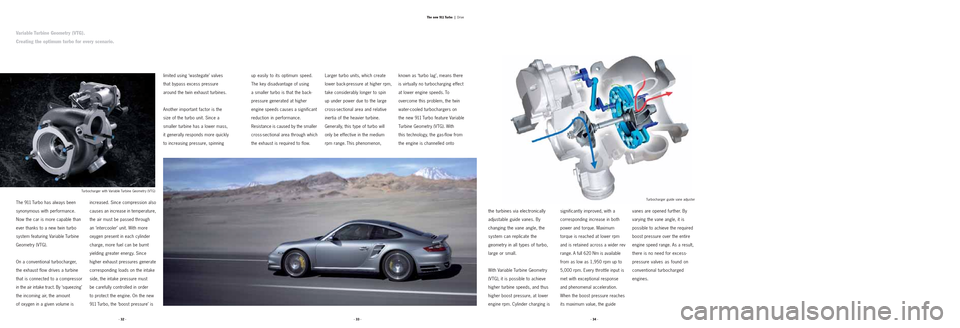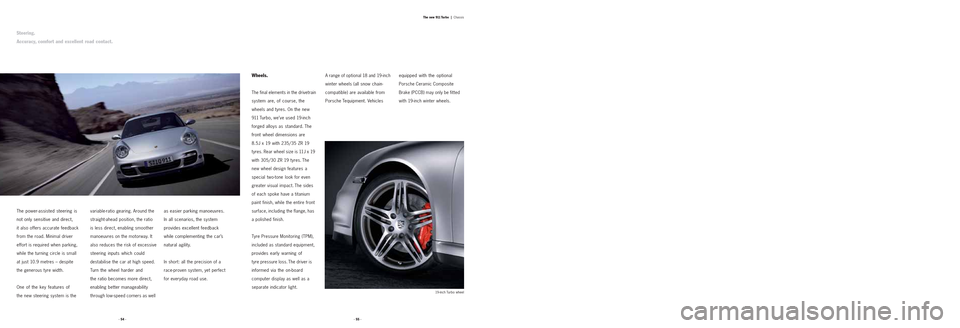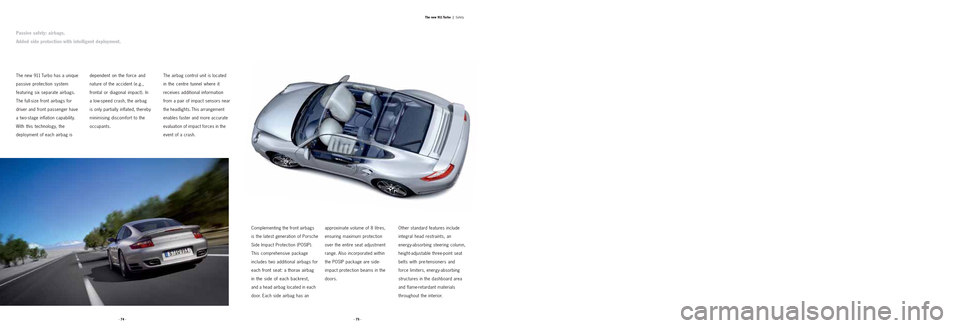tire size PORSCHE 911 TURBO 2004 4.G Information Manual
[x] Cancel search | Manufacturer: PORSCHE, Model Year: 2004, Model line: 911 TURBO, Model: PORSCHE 911 TURBO 2004 4.GPages: 61, PDF Size: 2.14 MB
Page 13 of 61

vanes are opened further. By
varying the vane angle, it is
possible to achieve the required
boost pressure over the entire
engine speed range. As a result,
there is no need for excess-
pressure valves as found on
conventional turbocharged
engines.
· 34 · · 32 ·· 33 ·The new 911 Turbo |
Drive
Variable Turbine Geometry (VTG).
Creating the optimum turbo for every scenario.
known as ‘turbo lag’, means there
is virtually no turbocharging effect
at lower engine speeds. To
overcome this problem, the twin
water-cooled turbochargers on
the new 911 Turbo feature Variable
Turbine Geometry (VTG). With
this technology, the gas-flow from
the engine is channelled onto Larger turbo units, which create
lower back-pressure at higher rpm,
take considerably longer to spin
up under power due to the large
cross-sectional area and relative
inertia of the heavier turbine.
Generally, this type of turbo will
only be effective in the medium
rpm range. This phenomenon,
Turbocharger guide vane adjuster Turbocharger with Variable Turbine Geometry (VTG)
up easily to its optimum speed.
The key disadvantage of using
a smaller turbo is that the back-
pressure generated at higher
engine speeds causes a significant
reduction in performance.
Resistance is caused by the smaller
cross-sectional area through which
the exhaust is required to flow.
The 911 Turbo has always been
synonymous with performance.
Now the car is more capable than
ever thanks to a new twin turbo
system featuring Variable Turbine
Geometry (VTG).
On a conventional turbocharger,
the exhaust flow drives a turbine
that is connected to a compressor
in the air intake tract. By ‘squeezing’
the incoming air, the amount
of oxygen in a given volume isincreased. Since compression also
causes an increase in temperature,
the air must be passed through
an ‘intercooler’ unit. With more
oxygen present in each cylinder
charge, more fuel can be burnt
yielding greater energy. Since
higher exhaust pressures generate
corresponding loads on the intake
side, the intake pressure must
be carefully controlled in order
to protect the engine. On the new
911 Turbo, the ‘boost pressure’ islimited using ‘wastegate’ valves
that bypass excess pressure
around the twin exhaust turbines.
Another important factor is the
size of the turbo unit. Since a
smaller turbine has a lower mass,
it generally responds more quickly
to increasing pressure, spinning
the turbines via electronically
adjustable guide vanes. By
changing the vane angle, the
system can replicate the
geometry in all types of turbo,
large or small.
With Variable Turbine Geometry
(VTG), it is possible to achieve
higher turbine speeds, and thus
higher boost pressure, at lower
engine rpm. Cylinder charging issignificantly improved, with a
corresponding increase in both
power and torque. Maximum
torque is reached at lower rpm
and is retained across a wider rev
range. A full 620 Nm is available
from as low as 1,950 rpm up to
5,000 rpm. Every throttle input is
met with exceptional response
and phenomenal acceleration.
When the boost pressure reaches
its maximum value, the guide
Page 23 of 61

The power-assisted steering is
not only sensitive and direct,
it also offers accurate feedback
from the road. Minimal driver
effort is required when parking,
while the turning circle is small
at just 10.9 metres – despite
the generous tyre width.
One of the key features of
the new steering system is thevariable-ratio gearing. Around the
straight-ahead position, the ratio
is less direct, enabling smoother
manoeuvres on the motorway. It
also reduces the risk of excessive
steering inputs which could
destabilise the car at high speed.
Turn the wheel harder and
the ratio becomes more direct,
enabling better manageability
through low-speed corners as well
as easier parking manoeuvres.
In all scenarios, the system
provides excellent feedback
while complementing the car’s
natural agility.
In short: all the precision of a
race-proven system, yet perfect
for everyday road use.
· 54 ·· 55 ·The new 911 Turbo |
Chassis
Wheels.
The final elements in the drivetrain
system are, of course, the
wheels and tyres. On the new
911 Turbo, we’ve used 19-inch
forged alloys as standard. The
front wheel dimensions are
8.5J x 19 with
235/35 ZR 19
tyres. Rear wheel size is 11J x 19
with 305/30 ZR 19 tyres. The
new wheel design features a
special two-tone look for even
greater visual impact. The sides
of each spoke have a titanium
paint finish, while the entire front
surface, including the flange, has
a polished finish.
Tyre Pressure Monitoring (TPM),
included as standard equipment,
provides early warning of
tyre pressure loss. The driver is
i
nformed via the on-board
computer display as well as a
separate indicator light.A range of optional 18 and 19-inch
winter wheels (all snow chain-
compatible) are available from
Porsche Tequipment. Vehicles
equipped with the optional
Porsche Ceramic Composite
Brake (PCCB) may only be fitted
with 19-inch winter wheels.
19-inch Turbo wheel
Steering.
Accuracy, comfort and excellent road contact.
Page 33 of 61

Complementing the front airbags
is the latest generation of Porsche
Side Impact Protection (POSIP).
This comprehensive package
includes two additional airbags for
each front seat: a thorax airbag
in the side of each backrest,
and a head airbag located in each
door. Each side airbag has anapproximate volume of 8 litres,
ensuring maximum protection
over the entire seat adjustment
range. Also incorporated within
the POSIP package are side-
impact protection beams in the
doors.Other standard features include
integral head restraints, an
energy-absorbing steering column,
height-adjustable three-point seat
belts with pre-tensioners and
force limiters, energy-absorbing
structures in the dashboard area
and flame-retardant materials
throughout the interior. The new 911 Turbo has a unique
passive protection system
featuring six separate airbags.
The full-size front airbags for
driver and front passenger have
a two-stage inflation capability.
With this technology, the
deployment of each airbag is
dependent on the force and
nature of the accident (e.g.,
frontal or diagonal impact). In
a low-speed crash, the airbag
is only partially inflated, thereby
minimising discomfort to the
occupants.
The airbag control unit is located
in the centre tunnel where it
receives additional information
from a pair of impact sensors near
the headlights. This arrangement
enables faster and more accurate
evaluation of impact forces in the
event of a crash.
· 74 ·· 75 ·The new 911 Turbo |
Safety
Passive safety: airbags.
Added side protection with intelligent deployment.